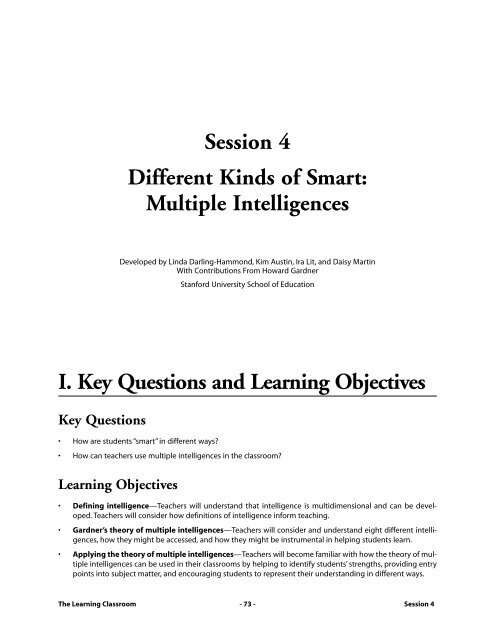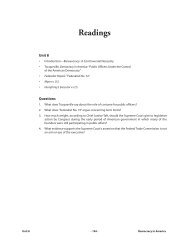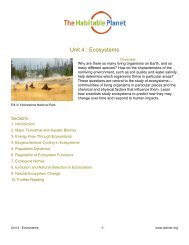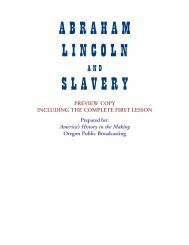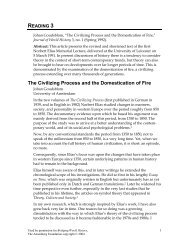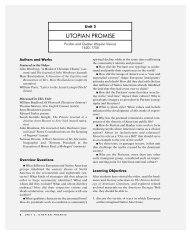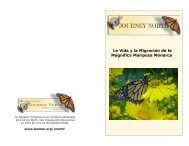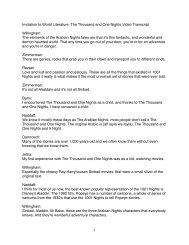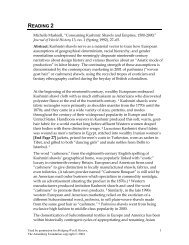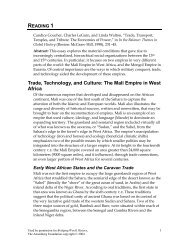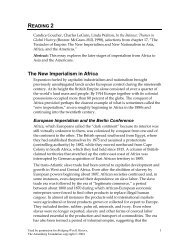Session 4 Different Kinds Of Smart: Multiple Intelligences
Session 4 Different Kinds Of Smart: Multiple Intelligences
Session 4 Different Kinds Of Smart: Multiple Intelligences
Create successful ePaper yourself
Turn your PDF publications into a flip-book with our unique Google optimized e-Paper software.
<strong>Session</strong> 4<br />
<strong>Different</strong> <strong>Kinds</strong> of <strong>Smart</strong>:<br />
<strong>Multiple</strong> <strong>Intelligences</strong><br />
Developed by Linda Darling-Hammond, Kim Austin, Ira Lit, and Daisy Martin<br />
With Contributions From Howard Gardner<br />
Stanford University School of Education<br />
I. Key Questions and Learning Objectives<br />
Key Questions<br />
• How are students “smart” in different ways?<br />
• How can teachers use multiple intelligences in the classroom?<br />
Learning Objectives<br />
• Defining intelligence—Teachers will understand that intelligence is multidimensional and can be developed.<br />
Teachers will consider how definitions of intelligence inform teaching.<br />
• Gardner’s theory of multiple intelligences—Teachers will consider and understand eight different intelligences,<br />
how they might be accessed, and how they might be instrumental in helping students learn.<br />
• Applying the theory of multiple intelligences—Teachers will become familiar with how the theory of multiple<br />
intelligences can be used in their classrooms by helping to identify students’ strengths, providing entry<br />
points into subject matter, and encouraging students to represent their understanding in different ways.<br />
The Learning Classroom - 73 - <strong>Session</strong> 4
II. <strong>Session</strong> Overview<br />
Think, for example, of sailors in the South Seas, who find their way around hundreds, or even thousands<br />
of islands by looking at the constellations of stars in the sky, feeling the way a boat passes over the water,<br />
and noticing a few scattered landmarks. A word for intelligence in a society of these sailors would probably<br />
refer to that kind of navigational ability. Think of surgeons and engineers, hunters and fishermen,<br />
dancers and choreographers, athletes and athletic coaches, tribal chiefs and sorcerers. All of these different<br />
roles need to be taken into account if we accept the way I define intelligence—that is, as the ability<br />
to solve problems, or to fashion products, that are valued in one or more cultural or community settings.<br />
—Howard Gardner (1993, p. 3)<br />
What does it mean to be smart? Tests of “intelligence” typically measure how well you read and write or how<br />
quickly you can work with numbers. In 1983, Howard Gardner presented an alternative view of intelligence. In his<br />
book, Frames of Mind, he outlined seven intelligences—linguistic and logical-mathematical (abilities typically<br />
measured by IQ tests), musical, spatial, bodily-kinesthetic (movement and motor skills), interpersonal (skills and<br />
abilities in working with others), and intrapersonal (self-knowledge and awareness). Since that time, Gardner has<br />
explored other areas that may also be included as human intelligences. In that pursuit, he added naturalistic<br />
intelligence—the ability to make distinctions in the natural environment—as the eighth intelligence.<br />
Gardner developed this expanded view of intelligence by reviewing studies of cognitive development in normal<br />
children, as well as exceptional individuals like prodigies and autistic children. Studies of stroke patients and other<br />
brain-damaged individuals who lost cognitive abilities provided further evidence of the different kinds of intelligences<br />
we possess. He used these sources of evidence and others to identify abilities that develop relatively independently<br />
of one another. As a result of this work, he found that in addition to the linguistic and<br />
logical-mathematical abilities traditionally valued in IQ tests, five other capacities met his criteria for intelligence.<br />
These, in combination, enable people to solve problems or fashion products with varying levels of skill in ways<br />
that are recognized and valued by our culture.<br />
Traditionally, IQ was seen as an innate capacity—something you are born with in a given quantity. However, multiple<br />
intelligences theory suggests that intelligences can develop and be developed over time. Although some<br />
individuals may have a special capacity for a certain type of intelligence (e.g., musical talent), all healthy individuals<br />
can nurture and develop their intelligences over a lifetime. <strong>Multiple</strong> intelligence (MI) theory suggests not only<br />
that people have differing interests and abilities, but that it is useful for lifelong learners to develop a range of abilities<br />
in addition to those required for reading, writing, and mathematics. In fact, these other intelligences—<br />
spatial, musical, interpersonal, intrapersonal, and bodily-kinesthetic—can often create useful pathways into<br />
developing essential literacy and quantitative skills, as well as playing valuable roles in their own right.<br />
In this session, we first define Gardner’s eight intelligences and then discuss three areas for classroom application<br />
of his theory:<br />
• Using MI theory to help understand students as learners and to provide opportunities for them to strengthen<br />
their abilities in different areas,<br />
• Introducing new topics by drawing on the diversity of ways we learn and understand, and<br />
• Developing lessons and curricula that require students to practice and apply multiple intelligences.<br />
One of the things we know about any intelligence is that it gets stronger when students practice and work at it.<br />
The more teachers can provide appropriate resources, the stronger the child’s abilities will become in that area.<br />
Ultimately, it is important to have many areas of intellectual strength. The art of teaching is helping people use<br />
their already well-developed abilities to build other strengths, so that they can master important learning in a<br />
variety of ways. Rather than providing a template for teaching—“If it’s Monday, it must be music day”—Gardner<br />
provides a way of thinking about the diversity of ways we learn, understand, perform, and create meaningful<br />
products.<br />
<strong>Session</strong> 4 - 74 - The Learning Classroom
II. <strong>Session</strong> Overview, cont’d.<br />
The Eight <strong>Intelligences</strong><br />
According to Gardner, an effective education builds a bridge between the content being taught and the students<br />
in the classroom:<br />
On the one hand, educators need to recognize the difficulties students face in attaining genuine understanding<br />
of important topics and concepts. On the other hand, educators need to take into account the<br />
differences among minds and, as far as possible, fashion an education that can reach the infinite variety<br />
of students (Gardner 1999, p. 186).<br />
Gardner (1983) emphasizes that an intelligence is most accurately thought of as a potential, and the various intelligences<br />
are sets of “know-how”—or ways of doing things. Most culturally valued tasks involve putting more than<br />
one intelligence into practice. For instance, lawyers must be well-practiced at writing briefs (linguistic intelligence),<br />
developing arguments (logical-mathematical), public speaking, and persuading a jury (bodily-kinesthetic,<br />
linguistic, and interpersonal). Similarly, concert pianists not only rely on musical intelligence, but must also rely on<br />
bodily-kinesthetic skills to develop their manual dexterity, as well as their intrapersonal skills to express the<br />
meaning of a piece of music (Kornhaber, Kreshevsky, & Gardner, 1990).<br />
The following definitions describe each intelligence and the related occupations and directions an intelligence<br />
might take. These are by no means the only examples, nor does the development of any one intelligence suggest<br />
the exclusion of others. All healthy people possess all the intelligences, which they blend in various ways when<br />
they create products or perform meaningful roles or tasks.<br />
• Linguistic intelligence—Linguistic intelligence involves the ability to communicate and use language in a<br />
variety of ways—through speaking, writing, and reading. This intelligence includes a sensitivity to the<br />
meaning of words, the order of words, and the sounds and rhythm of words. Poets, journalists, and speechwriters<br />
exhibit strengths in this intelligence. Students who enjoy playing with language, telling stories, and<br />
who quickly acquire foreign languages exhibit linguistic intelligence.<br />
• Musical intelligence—We put into practice musical intelligence when we create and perceive sound patterns.<br />
Musical intelligence includes a sensitivity to pitch (melody), rhythm, and the qualities of a tone (Gardner,<br />
1983). Composers, singers, conductors, and musicians exhibit this intelligence, as do poets and others who<br />
use word sounds and rhythms in their writing. Students who sing well, enjoy making rhythmic sounds, and<br />
can distinguish between notes are displaying musical intelligence.<br />
• Logical-mathematical intelligence—Logical-mathematical intelligence is involved when we order objects,<br />
assess their quantity, and make statements about the relationships among them. Scientists, mathematicians,<br />
and philosophers all display strength in these areas. You can observe this intelligence in students who can<br />
carry out complex calculations in their heads, enjoy finding patterns in shapes and numbers, and excel at<br />
making logical arguments.<br />
• Spatial intelligence—We use spatial intelligence when we perceive a form or object (either visually or through<br />
touch), when we remember visual or spatial information, and when we recognize and imagine objects from<br />
different angles (Gardner, 1985). Spatial ability is often assessed by having people copy shapes or match one<br />
visual image with another. Architects, mechanics, and engineers possess strong spatial abilities. Spatial intelligence<br />
can be observed in students who understand and can create visual images of their understanding—<br />
like charts, diagrams, or maps—as well as students who are drawn to the visual arts.<br />
• Bodily-kinesthetic intelligence—Bodily-kinesthetic intelligence is visible when people use their bodies to<br />
create products or solve problems. Athletes, surgeons, dancers, choreographers, and craftspeople display<br />
competency in this area. Students strong in bodily-kinesthetic abilities show good coordination and gross<br />
motor skill—on the stage or playing field—or the fine motor skills involved in making models or sculptures.<br />
The Learning Classroom - 75 - <strong>Session</strong> 4
II. <strong>Session</strong> Overview, cont’d.<br />
• Interpersonal intelligence—People exhibit interpersonal intelligence when they display an awareness or sensitivity<br />
to others’ feelings and intentions. Teachers, parents, politicians, psychologists, and salespeople rely on<br />
interpersonal intelligence in their work. Students exhibit this intelligence when they collaborate well, when<br />
they show thoughtfulness and sensitivity toward their friends, and when they interact with ease with others<br />
of all ages.<br />
• Intrapersonal intelligence—Intrapersonal intelligence helps individuals to “distinguish among their own feelings,<br />
to build accurate mental models of themselves, and to draw on these models to make decisions about<br />
their lives”(Kreshevsky & Siedel, 1998, p. 20). Therapists and religious leaders may exhibit strength in this intelligence.<br />
Students who understand their strengths and weaknesses, have an awareness of their own emotional<br />
states, and are thoughtful when they make decisions about their lives are displaying intrapersonal<br />
intelligence. [See <strong>Session</strong> 5, Emotions and Learning, for a more in-depth discussion of “emotional intelligence”<br />
(Goleman, 1995).]<br />
• Naturalistic intelligence—Finally, naturalistic intelligence allows people to recognize and classify species and<br />
other aspects of their environment. Farmers, gardeners, botanists, geologists, florists, and archaeologists all<br />
exhibit this intelligence. Students who enjoy studying the world around them—insects, cars, or stamps—<br />
display strength in this intelligence.<br />
These definitions can serve as guides to help us think about individual learning styles and preferences that can be<br />
developed over time. To prepare learners for the variety of occupations and roles they may have when they leave<br />
school, teachers might consider the kind of practice they are providing in these life skills—working with others,<br />
developing a sense of one’s own abilities, creating, performing, and problem solving in different areas.<br />
Each of these competencies has its own developmental trajectory, progresses at different rates, and results in differing<br />
intelligence “profiles” in individuals:<br />
. . . [L]anguage develops rapidly in almost everyone. Interpersonal competence also develops in almost<br />
everyone, but far more slowly. The speed and extent of musical development varies widely from person<br />
to person .... [A] given individual’s musical and linguistic competencies may develop rapidly and to a high<br />
degree; his or her bodily kinesthetic and spatial competencies might also be high, but logicalmathematical<br />
and personal competences might lag behind others. These different profiles, trajectories,<br />
and rates of development enable a person to grasp, more or less readily, the symbol systems in which the<br />
domains of his or her culture are transmitted (Kornhaber, Krechevsky, & Gardner, 1990, pp. 183-184).<br />
This view of intelligence is quite different from the traditional one. Our cognitive abilities are not fixed and predetermined;<br />
they change and develop over time.<br />
<strong>Multiple</strong> <strong>Intelligences</strong> in the Classroom<br />
Since the publication of Frames of Mind, MI theory has had a great impact on schools and teachers. In a study of<br />
41 schools using MI theory, researchers found that putting MI theory into practice was associated with improved<br />
test scores, improved student behavior, improved parent participation, and positive outcomes for students identified<br />
with learning disabilities (Project SUMIT: Outcomes. Retrieved from http://www.pz.harvard.edu/SUMIT/OUT-<br />
COMES.HTM). Interviews with principals and teachers in these schools suggested that using MI theory helps<br />
schools in several ways: It provides teachers with a framework for discussing children’s strengths and weaknesses;<br />
it promotes the arts, including music, drama, and dance; and it promotes choice and individualization of education.<br />
In the following sections, we outline three ways teachers can draw on Gardner’s theory in their classrooms:<br />
by assessing and building on students’ strengths, by providing points of entry to subject matter, and by creating<br />
interdisciplinary curricula.<br />
<strong>Session</strong> 4 - 76 - The Learning Classroom
II. <strong>Session</strong> Overview, cont’d.<br />
Assessing and Building on Students’ Strengths<br />
In order for students to remain motivated in school, they need opportunities to succeed in learning. An important<br />
aim of schooling is to give students opportunities to feel successful. Teaching focused on multiple intelligences<br />
can identify the areas where students excel and provide opportunities for students with different kinds of minds<br />
to flourish and to find pathways into all kinds of material. Teachers identify individual differences through careful<br />
observation and activities that reveal strengths, preferences, and abilities. Once these differences are identified,<br />
instruction can provide supports for students who learn in different ways. For instance, students who are interested<br />
in art can be given the choice of first illustrating an idea or topic and then composing a short story; the student<br />
who seems particularly strong in spatial thinking can be given the opportunity to work with manipulatives<br />
to explore mathematical concepts; the student who exhibits strong interpersonal skills can be called on to lead a<br />
group investigation.<br />
However, a student’s preferred mode of intelligence should not become the medium for all of the student’s work<br />
in place of developing other needed abilities. A student who has well-developed ability in the spatial domain<br />
should not always be encouraged to create visual representations instead of writing. Linguistic skills need to be<br />
developed as well. Similarly, a student’s interest and proficiency in music may provide a topic for an essay or the<br />
background for writing the essay, but should not become a substitute for learning to write proficiently.<br />
Teachers should also be careful to avoid the “pigeon-holing effect”—labeling students forever as “X” types of<br />
learners. All individuals possess certain combinations of the various intelligences, and they can apply these differently<br />
in different contexts. We can look for specialized strengths in individuals and use them to assist learning, but<br />
attaching a permanent label can discourage future success in “weak” areas. We all have potential in all of the intelligences<br />
and it is important to understand that children’s intelligences grow and vary over time and contexts<br />
(Hatch, 1997).<br />
How can these differing intelligences be assessed? Observation plays an important role in understanding students’<br />
intelligence profiles. Observing how children approach problems and make products reveals much about<br />
their intelligences. Kreshevsky and Seidel (1998) suggest teachers look for the following things to develop better<br />
understandings of individual students:<br />
• What choices do students make when given options?<br />
• What roles do they play when working together?<br />
• How do they handle unanticipated problems?<br />
• What captures their attention? When do they lose interest?<br />
• What problem-solving strategies do they offer?<br />
• How do they communicate ideas, understandings, thoughts, and feelings?<br />
• What does their physical behavior suggest?<br />
Researchers at Project Spectrum (a collaboration between Harvard and Tufts Universities) developed activities<br />
and observational checklists to help teachers of young students recognize students’ intelligences. For example:<br />
Spectrum divides the movement domain into athletic and creative movement. Athletic abilities include<br />
power, agility, speed, and balance, and creative movement includes body control, sense of rhythm,<br />
expressiveness, and generation of movement ideas. This delineation helps teachers make sense of key<br />
aspects of a domain with which they may not be familiar (Kreshevsky & Seidel, 1998, p. 24).<br />
Among the ways that teachers can document students’ intelligences in the busy life of the classroom are keeping<br />
track of when individuals get frustrated, paying attention to when a student seems particularly engaged, and<br />
documenting students’ questions and ideas (Kreshevky & Seidel, 1998).<br />
MI theory also recommends a range of classroom assessments that tap into the different ways students think and<br />
learn. When assessments are carried out in the context of a project or unit, several intelligences can be tapped.<br />
The Learning Classroom - 77 - <strong>Session</strong> 4
II. <strong>Session</strong> Overview, cont’d.<br />
For instance, at the completion of a project researching water quality in the community, asking students to create<br />
a public service brochure to describe and report what they learned could involve linguistic, logical-mathematical,<br />
visual-spatial, and interpersonal skills. The more authentic the task, the more intelligences are drawn on.<br />
Portfolios and public presentations that are evaluated by outside audiences also provide opportunities for students<br />
to share what they have learned through several communication modes. They also offer the benefit of<br />
tracking growth and development over time. For instance, in a number of schools in New York City, seniors must<br />
complete a graduation portfolio. Each student is asked to show achievement in literature, history, mathematics,<br />
and science, and also demonstrate accomplishment in fine arts exhibits and critiques, community service, ethics<br />
and social issues, and a physical challenge (Darling-Hammond, Ancess, & Ort, 2002). Gardner (1993) also proposes<br />
the idea of a “processfolio,” an activity that gives students an opportunity to include both finished and unfinished<br />
work and to reflect on the many different skills and abilities they used to complete certain products. Such assessments<br />
not only provide valuable information about students’ strengths and achievements, but also communicate<br />
that there is more than one way to be “smart.”<br />
Providing Powerful Points of Entry<br />
Part of being an intelligent learner is demonstrating that you can think about the same idea in different ways. In<br />
fact, if you have more than one way of thinking about something, you are much less likely to forget it. In The<br />
Disciplined Mind, Gardner (1999) describes how teachers can reach each diverse group of students by introducing<br />
and presenting rich topics in a different ways. He suggests three ways teachers can enhance students’ understanding:<br />
• By providing powerful points of entry—MI theory provides many ways to introduce and approach a topic,<br />
• By offering apt analogies—connecting new topics to ideas and concepts that are more readily familiar to students,<br />
and<br />
• By providing multiple representations of the central or core ideas of the topic.<br />
Traditionally, new topics may be introduced through a lecture-like introduction, a chapter overview, or demonstration<br />
of a rule or principle. Gardner suggests several other ways to introduce new material, based on different<br />
intelligences, for example, through narrative, numerical, aesthetic, and hands-on points of entry. A narrative entry<br />
point would involve introducing a new concept by telling a story or narrative: introducing evolution by telling the<br />
story of a single branch on an evolutionary tree or describing the concept of democracy by telling the story of its<br />
beginning in ancient Greece (Gardner, 1993). Both of these examples draw on narrative modes of understanding.<br />
A topic of study might also be introduced in a numerical or quantitative manner. For instance, students could be<br />
introduced to a unit on evolution by analyzing a map that shows the number of different species existing in different<br />
geographic areas or they could be introduced to a unit on Mayan culture by considering population shifts<br />
over time.<br />
An aesthetic approach to introducing new material might involve watching a movie that introduces a historic<br />
event, discussing artwork of a specific period, or responding to poetry read aloud. A hands-on point of entry<br />
would provide opportunities for students first to manipulate and explore materials—weights and levers, computer<br />
simulations, or the fur of different animals—before launching into a unit of study. Each of these approaches<br />
provides a way into new material, designed to engage students’ interests and promote thinking and learning in a<br />
variety of ways.<br />
Analogies provide a different kind of hook in introducing new information. They attempt to create a bridge<br />
between students’ current understanding and the new material to be learned. According to Gardner, “Stripped<br />
down, analogies are simply examples drawn from another realm of experience, a realm presumably more familiar<br />
to the students than the topic at hand” (Gardner, 1999, p. 199). In science, for example, one could describe the<br />
human eye as like a camera, the heart as like a pump, or a cell as similar to a factory. Although each analogy is limited<br />
to a certain extent, offering a similar situation, an evocative image, or a narrative plot can help students begin<br />
to grapple with complex subject matter.<br />
<strong>Session</strong> 4 - 78 - The Learning Classroom
II. <strong>Session</strong> Overview, cont’d.<br />
And, finally, introducing and encouraging multiple representations of the same core ideas can also help learners<br />
with differing strengths find their own ways into new material. The same idea can often be thought of in many<br />
different ways. The eight intelligences can help us think about a variety of ways an idea may be represented. For<br />
instance, the same algebra problem can be discussed in linguistic terms (through a verbal description), mathematical<br />
terms (with numerical symbols), and spatial terms (with a graph of the relationships represented). Similarly,<br />
the plot of a novel can be described verbally or mapped out visually with a diagram of the relationships<br />
among characters. MI theory offers us several ways of thinking in the service of introducing, clarifying, and helping<br />
students make sense of new material.<br />
Creating Interdisciplinary Curricula<br />
The intelligences are pathways or entry points to understanding, not necessarily ends in and of themselves. More<br />
important than simply drawing on the differing intelligences is being clear about teaching and learning goals.<br />
There are many ways a teacher can incorporate multiple intelligences in the service of understanding. In this session’s<br />
video of Georganne Urso-Flores’s and Rebecca Young’s first- and second-grade class, the teachers’ goal is for<br />
their students to understand the structure of flowers, including the names and functions of different parts of a<br />
flower. They demonstrate many ways to teach this lesson, through reading, dissecting flowers, and building a<br />
model, among other strategies. This approach demonstrates to students that understanding means being able to<br />
think about an idea in more than one way. As we see in the high school segment of this session’s video, Tom<br />
Romito asks his students to develop an understanding of the 1970s in terms of the history, culture, politics, social<br />
movements, and economic forces at play. Students draw on different intelligences as they interact, write, and<br />
develop artistic and dramatic presentations.<br />
There are many ways to incorporate MI theory in a classroom. A teacher might teach algebraic graphing both spatially<br />
and kinesthetically by taking her class out to the playground and asking students to plot their bodies as<br />
points on a life-size graph. In a writing lesson, a teacher can use peer review to draw on interpersonal intelligence,<br />
and reflection on the writing process to draw on intrapersonal intelligence, in addition to linguistic intelligence<br />
used in the writing itself. To teach the process of photosynthesis in plants, teachers could develop hands-on plant<br />
growth experiments or provide access to a school garden for exploration, in addition to reading a text, drawing<br />
models of the process and discussing it—drawing on spatial, bodily-kinesthetic, and interpersonal intelligences.<br />
Charts, diagrams, conceptual maps, and opportunities to dissect plants or use microscopes might assist learners<br />
with a preference for logical and spatial modes. Throughout the unit, the teacher could provide multiple ways for<br />
students to share their growing understanding of the concepts. Groups of students might have miniconferences<br />
with the teacher to discuss their ideas (interpersonal and linguistic realms); they might write essays, draw illustrations,<br />
and so forth. The goal is not simply to develop a number of different kinds of activities, but to provide<br />
opportunities for students to connect with content and express their understanding in different ways.<br />
Through longer-term projects that span weeks or months, students can conduct inquiries into class topics, like a<br />
study of local birds and their nesting habits or research focused on current issues in local government. As<br />
Campbell (1997) observed in her study of multiple-intelligence classrooms, opportunities for in-depth, selfdirected<br />
learning help prepare students by teaching them how to manage complex projects:<br />
Students learn to ask researchable questions; to identify varied resources; to create realistic timelines;<br />
and to initiate, implement, and bring closure to a learning activity. Regardless of disciplinary focus, these<br />
projects typically draw on numerous intelligences (Campbell, 1997, p. 4).<br />
For instance, researching and building a clubhouse involves mathematical and spatial abilities when measuring<br />
and drawing up plans, draws on interpersonal skills and intrapersonal awareness in collaborating with others, and<br />
relies on bodily-kinesthetic intelligence in creating the actual structure.<br />
By expanding the ways material is introduced, as well as the modes through which students can express what<br />
they are learning, the teacher can tap into the different ways students best learn and work. At the same time, there<br />
is no formula for using a maximum number of intelligences. As Gardner notes, “... most topics can be powerfully<br />
approached in a number of ways. But there is no point in assuming that every topic can be effectively approached<br />
in at least seven ways” (Gardner, 1995, p. 206).<br />
The Learning Classroom - 79 - <strong>Session</strong> 4
II. <strong>Session</strong> Overview, cont’d.<br />
Interdisciplinary curricula and projects may also be seen school-wide as teachers and administrators choose a<br />
theme—like international awareness or the Renaissance—to focus on across subjects and grades for a period of<br />
time. Some schools have organized curricula thematically by merging English with the visual and performing arts.<br />
Interdisciplinary units in such schools may begin with a provocative question like “How do we use imagination to<br />
explain our world?” (Campbell, 1997). Teachers at a school might also collaborate by planning and teaching in<br />
teams using their own intelligence strengths for some aspects of the unit and having students rotate from classroom<br />
to classroom.<br />
Finally, apprenticeships in the arts, sports, crafts, humanities, or applied mathematics and science can allow students<br />
to gain expertise in a skill area by working with professional members in their communities. At the Key<br />
School in Indianapolis, for example, teachers, parents, and community members mentor students in 17 crafts or<br />
disciplines (Campbell, 1997). Groups of students work with these mentors four times a week on topics like city<br />
planning, aerospace, and vocal music. Local museums and industries can also offer student apprenticeships based<br />
on real-world tasks and focused on a particular intelligence or discipline. These apprenticeships—as is most reallife<br />
work—are by their nature interdisciplinary, relying on more than one intelligence for the successful completion<br />
of projects and products.<br />
Conclusion<br />
MI theory prompts a consideration of what it means to solve problems in different disciplines using all of the<br />
human abilities at our disposal. Taking on a multiple-intelligence stance, a teacher might ask of her own teaching:<br />
“How can I learn about my students’ preferences and strengths in the eight intelligences? What kinds of assessments<br />
can I create that provide opportunities for students to use and demonstrate their strengths in different<br />
areas? How can I think about introducing a rich and important concept in my subject area through a range of different<br />
intelligences? Which intelligences may I be neglecting in my teaching? How can I include these in some of<br />
what I do?”<br />
MI theory is a way of thinking about how children learn and how best to teach them. The theory provides a way<br />
of thinking about how we learn that urges teachers to extend the boundaries of traditional curriculum, consider<br />
the many talents and abilities students bring to a school setting, and put greater emphasis on the variety of skills<br />
necessary to succeed in today’s world.<br />
III. Additional <strong>Session</strong> Readings<br />
Hatch, T. (1997). Getting specific about multiple intelligences. Educational Leadership, 54(6). [Online]. Available:<br />
http://www.ascd.org/readingroom/edlead/9703/hatch.html.<br />
Sternberg, R. J. (1997, March). What does it mean to be smart? Educational Leadership, 54(6), 20-24. [Online]. Available:<br />
http://ascd.org/readingroom/edlead/9703/sternberg.html.<br />
<strong>Session</strong> 4 - 80 - The Learning Classroom
IV. <strong>Session</strong> Activities<br />
Getting Started<br />
Answer one of the following questions in a free-write, pairshare,<br />
or small-group discussion.<br />
1. Think of a complex task that you recently had to finish<br />
in your life. (Examples might be building a walkway,<br />
planning a vacation, persuading a friend, or figuring<br />
out your taxes.) Briefly describe this task.<br />
• What abilities did you use to accomplish this task?<br />
• What parts of the task were more difficult? Which<br />
parts of the task were easier?<br />
• Did you get better at any part of this task by the<br />
time you were done? Did any of your abilities<br />
become sharper as the task proceeded?<br />
OR<br />
2. Finish the following sentence: I am intelligent because I can ______.<br />
• How easy or difficult was it to finish this sentence?<br />
• How do you explain the ease or difficulty of this task?<br />
• What definition of intelligence is implied by your statement? How do you define intelligence?<br />
• How might your definition and understanding of intelligence influence your teaching practice?<br />
Discussion of <strong>Session</strong> Readings<br />
To the Facilitator: These activities can be used<br />
as session warm-ups or as activities that occur<br />
after video viewing.<br />
To the Facilitator: You may want to have a few<br />
learners share their responses to this prompt.<br />
Keep a list of the abilities learners mention on<br />
the board. Ask their peers if they imagine using<br />
other abilities to complete the same task. After<br />
reading the session overview, you can come<br />
back to this list of abilities and use them to illustrate<br />
specifics of Gardner’s eight intelligences.<br />
To the Facilitator: You may want to select questions from the Other Learning Activities and<br />
Assessments section to launch a discussion of the session readings. The questions used for the<br />
Checking for Understanding activities may be a particularly helpful resource.<br />
The Learning Classroom - 81 - <strong>Session</strong> 4
IV. <strong>Session</strong> Activities, cont’d.<br />
<strong>Session</strong> Video<br />
<strong>Multiple</strong> intelligence (MI) theory describes how people learn and demonstrate their learning in different ways.<br />
When teachers apply MI theory to the classroom, it changes the way they view their students and the way they<br />
teach. This session’s video demonstrates how MI theory allows two things to happen: it offers students multiple<br />
entry points into one topic, and it deepens students’ understanding of a concept by allowing them to approach it<br />
from a variety of angles.<br />
Background on Teachers<br />
Rebecca Young co-taught multiage first- and second-grade students at Ann Visger Elementary School, River<br />
Rouge, Michigan at the time of this taping. A 33-year veteran of teaching, Ms. Young received her bachelor’s<br />
degree in elementary education from the University of Michigan and her master’s degree in reading and learning<br />
disabilities from the University of Detroit. She is a National Board-certified teacher and was a Wayne County Outstanding<br />
Teacher of the Year Finalist in 2002. She now works for the Michigan Department of Education.<br />
Georganne Urso-Flores co-teaches multiage first- and second-grade students at Ann Visger Elementary School,<br />
River Rouge, Michigan. She has 30 years of teaching experience and received her master’s degree in the teaching<br />
of reading and her bachelor’s degree in elementary education with a concentration in social studies/science, both<br />
from Oakland (Michigan) University. Ms. Urso-Flores is a National Board-certified teacher and was a Wayne County<br />
Outstanding Teacher of the Year Finalist in 2002.<br />
The first segment in this video features teaching partners Georganne Urso-Flores and Rebecca Young and their<br />
students ages five through eight, including special-education students. Their students are learning about the<br />
structure and function of plants as they rotate through learning centers focused on each of the intelligences.<br />
Tom Romito team teaches ninth- and 10th-grade writing, literature, and U.S. history at Lake Orion High School,<br />
Lake Orion, Michigan. He has eight years of teaching experience. Mr. Romito holds a master’s degree in political<br />
science from Wayne State University and a bachelor’s degree in English from the University of Michigan, Ann<br />
Arbor.<br />
The second segment in this video features Tom Romito and his freshman and sophomore humanities students.<br />
This is an interdisciplinary, multiage, multiability block class that includes general, college preparatory, and<br />
special-education ninth and 10th graders. Mr. Romito’s class is near the end of a year-long study of the United<br />
States in the twentieth century. They are in the middle of a unit about the 1970s, in which groups have researched<br />
several issues that led to important social legislation. The students use a variety of intelligences as they prepare<br />
and then present theatrical skits that introduce their classmates to the social, political, economic, and environmental<br />
challenges of this decade. After the skits, each group discusses the information they discovered with the<br />
class, and together they consider the impact of this era on the society we live in today. Finally, they write essays<br />
about the issues they have researched.<br />
<strong>Session</strong> 4 - 82 - The Learning Classroom
IV. <strong>Session</strong> Activities, cont’d.<br />
Discussion of <strong>Session</strong> Video<br />
To the Facilitator: You may want to pause the tape at the following points to discuss these questions.<br />
If you are watching a real-time broadcast on the Annenberg/CPB Channel, you may want to<br />
consider the questions as you watch and discuss some of them afterward.<br />
1. Learning About Your Students (Georganne Urso-Flores and Rebecca Young)<br />
Video Cue: The Learning Classroom icon fades out at approximately 12:30 into the program.<br />
Audio Cue: Ms. Urso-Flores says,“Choice time is a very important part of our day. And because they get to choose<br />
and when you have the grade to look at their intelligences that they’re very comfortable with and they enjoy.”Ms.<br />
Young says, “It also allows us to play with them, which is another way to really learn a lot about a child.”<br />
• What strategies do you notice these teachers using to learn about their students and how they like to learn?<br />
• How might you integrate (or have you integrated) similar strategies into your curriculum?<br />
2. Students Monitoring Their Own Learning (Georganne Urso-Flores and Rebecca<br />
Young)<br />
Video Cue: The Learning Classroom icon fades out at approximately 13:15 into the program.<br />
Audio Cue: Ms. Young says, “Definitely has changed the way I look at intelligence. I think that it’s very easy to fall<br />
into just honoring linguistic and mathematical intelligences, but now I can see how wonderful it is and how really<br />
smart all of our students are.”<br />
• Why do you think the teachers might include this debriefing of “ways of being smart” in their daily lesson?<br />
• How might discussion with students about multiple intelligences affect students’ capacities and motivation<br />
to learn?<br />
• How might learning about multiple intelligences affect students’ perceptions of each other?<br />
• Can you think of other ways students could identify and monitor their learning preferences?<br />
3. Using Strengths To Build Confidence To Take Risks (Tom Romito)<br />
Video Cue: The Learning Classroom icon fades out at approximately 21:30 into the program.<br />
Audio Cue: Mr. Romito says, “But what ... one thing that we’re able to do is use some of these multiple intelligences<br />
to give students opportunities to focus on their own strengths and, when they do that, it does build confidence<br />
and gives them some confidence to take that and apply it to something else.”<br />
• What are the teacher’s goals in this lesson?<br />
• How have these teachers used the skit activity to help all students learn?<br />
• Why might they have chosen this activity?<br />
• What are some possible next steps for these students?<br />
The Learning Classroom - 83 - <strong>Session</strong> 4
IV. <strong>Session</strong> Activities, cont’d.<br />
4. <strong>Multiple</strong> <strong>Intelligences</strong> as a Route Toward Lasting Learning (Tom Romito)<br />
Video Cue: The Learning Classroom icon fades out at approximately 23:15 into the program.<br />
Audio Cue: Mr. Romito says, “And if we’re asking them to perform these tasks or do things a certain way, they’ve<br />
gotta think about it, they have to interact with each other, and those are the skills that are, they’re really gonna<br />
take with them.”<br />
• Think of some of the real-world tasks you engage in every day. What intelligences do they draw upon?<br />
• Think of a topic being studied in your classroom. What are some opportunities for using MI you could imagine<br />
using in studying this topic?<br />
V. Other Learning Activities<br />
and Assessments<br />
To the Facilitator: These activities and assessments are for you to choose from according to your<br />
group’s needs and interests. Many of the activities offered here would work equally well as assignments<br />
both inside and outside of class. You may want to use class time to prepare for and/or reflect<br />
on any activities assigned as homework.<br />
Applications<br />
1. Journal<br />
In your classroom, what are you currently doing to use MI theory to strengthen and support student learning?<br />
Consider how you use various intelligences to help students to access and understand ideas, represent concepts,<br />
and build on students’ strengths. What kinds of successes have you had using this approach? What questions and<br />
concerns do you have?<br />
2. Field Assignments<br />
a. Describe and analyze a learning environment using a concept central to learning theory as a lens. MI theory can<br />
be used in a variety of ways within the classroom. Observe a classroom lesson or series of lessons and analyze<br />
if and how this theory is influencing instruction. Use the following questions and considerations as guides,<br />
but feel free to describe and analyze other aspects you see as integral to the theory. Use specific, detailed evidence<br />
to support your assertions.<br />
[continued next page]<br />
<strong>Session</strong> 4 - 84 - The Learning Classroom
V. Other Learning Activities<br />
and Assessments, cont’d.<br />
Field Assignment (a), cont’d.<br />
• Is there evidence in the classroom that students’ multiple intelligences are considered and included in<br />
the teaching plan?<br />
• Are there multiple ways students can access and connect to the topic and/or show their<br />
understanding?<br />
• Are different kinds of intelligences and capabilities required for students to complete learning tasks?<br />
• What kinds of resources and materials appropriate to different intelligences are available to<br />
students? What kinds of student work are visible?<br />
• How do students and teachers talk about their abilities?<br />
• Which intelligences are included in this lesson series?<br />
• Are students’ intelligences accessed in service of an academically important goal (e.g., core concept,<br />
skill, authentic task)?<br />
b. Evaluate and revise a lesson. In a group, pick a concept or topic you teach. Generate four ways to introduce or<br />
represent this topic in your classroom. Identify how each method taps into different intelligences.<br />
Be clear about the learning goals of the lesson and use these goals to guide your planning choices in the<br />
lesson.<br />
These ideas can be summarized on poster paper and shared with the class via presentations or a gallery walk.<br />
c. Observe a student. Think about a student or two students in your classroom (or the classroom you are<br />
observing) whom you would like to better understand. Use MI theory to learn more about these students in<br />
order to engage and support their learning. You may use the following questions and considerations as<br />
guides, but feel free to describe and analyze other aspects you see as integral to the theory. You may also<br />
interview the student about his learning preferences. Use specific, detailed evidence to support your<br />
assertions.<br />
• What choices does he make when given options?<br />
To the Facilitator: Please see Thomas<br />
•<br />
•<br />
What roles does he play when working with other students?<br />
How does he handle unanticipated problems?<br />
Armstrong’s (1994) book, <strong>Multiple</strong><br />
<strong>Intelligences</strong> in the Classroom (published<br />
by ASCD), for a more detailed<br />
• What kinds of problem-solving strategies does he offer?<br />
set of questions designed to help<br />
teachers better understand their stu-<br />
• What captures his attention? When does he lose interest? dents’ intelligences. See, in particular,<br />
• How does he communicate ideas,<br />
thoughts, and feelings?<br />
understandings,<br />
his “Checklist for Assessing Students’<br />
<strong>Intelligences</strong>,” on pages 29-31.<br />
• What does his physical behavior suggest?<br />
• What are his outside interests and hobbies?<br />
• How do you think this student likes to learn? How do you know?<br />
• What else do you want to know about this student’s intelligences?<br />
• What kinds of learning activities might you plan to capitalize on this student’s preferences and<br />
capabilities?<br />
The Learning Classroom - 85 - <strong>Session</strong> 4
V. Other Learning Activities<br />
and Assessments, cont’d.<br />
Checking for Understanding<br />
1. Short-Answer Questions<br />
a. What are some of the ways MI theory can be used in the classroom to enhance student learning?<br />
b. What are the dangers of “pigeon-holing” a student as a learner with a particular intelligence?<br />
2. Essay Questions<br />
a. Explain MI theory. How does Gardner describe and define intelligence? How does his definition differ from<br />
other ideas about intelligence?<br />
b. What are some advantages of using MI theory in our schools? What are some specific teaching practices that<br />
this theory supports? What are some concerns about the way MI theory might be used?<br />
3. Reflective Essay<br />
Write a reflective essay on what you learned in this unit.<br />
• What ideas stand out for you as the most useful and helpful?<br />
• How do you think these ideas might affect your own teaching?<br />
• What questions remain for you about these issues?<br />
Long-Term Assignments<br />
Curriculum Case Study<br />
Consider your case study learning problem from a multiple intelligences perspective. (Note: If your curriculum<br />
case is on a unit you plan to teach in the future, answer in the form of what you project for that unit. You may have<br />
to anticipate some of your students’ reactions.)<br />
• How did students’ different ways of learning influence what occurred in your curriculum case?<br />
• If you incorporated MI theory, how did you hope that accessing students’ multiple intelligences would help<br />
them master the skill/content/processes you were aiming to teach?<br />
• What were your concerns, if any, about incorporating these multiple intelligences into your planning?<br />
See the Field Assignment above, “Describe and analyze a learning environment,” (under Applications) for more<br />
guiding questions.<br />
To the Facilitator: You will find other learning<br />
activities on the course Web site at<br />
www.learner.org/channel/courses/learningclassroom.<br />
You will want to look ahead to assign<br />
learners the reading and any homework for the<br />
next session.<br />
<strong>Session</strong> 4 - 86 - The Learning Classroom
VI. Web Sites and Organizations<br />
Project Zero at the Harvard Graduate School of Education: http://www.pz.harvard.edu/Default.htm<br />
Project Zero is a research center at Harvard University’s School of Education. Its mission is to support learning,<br />
thinking, and creativity in the arts and other disciplines. This Web site includes project descriptions and publications<br />
summarizing research in these areas.<br />
Project SUMIT: Schools Using <strong>Multiple</strong> <strong>Intelligences</strong> Theory: http://pzweb.harvard.edu/SUMIT/Default.htm<br />
Schools Using <strong>Multiple</strong> <strong>Intelligences</strong> (SUMIT), a research project at Harvard University’s Project Zero, investigates<br />
how schools have put Howard Gardner’s multiple intelligences (MI) theory into practice. The site includes an<br />
overview of MI theory, information about the research project and student outcomes, and ideas and examples for<br />
implementing the theory in classrooms.<br />
VII. References and<br />
Recommended Readings<br />
Note that recommended readings are marked with an asterisk (*).<br />
*Armstrong, T. (2000). <strong>Multiple</strong> intelligences in the classroom. Alexandria, VA: Association for Supervision and<br />
Curriculum Development.<br />
*Campbell, L. (1997). Variations on a theme: How teachers interpret MI theory. Educational Leadership, 55(1),<br />
14-19.<br />
Darling-Hammond, L., Ancess, J., & Ort, S. (2002, Fall). Reinventing high school: Outcomes of the coalition campus<br />
schools project. American Educational Research Journal, 39 (3), pp. 639-673.<br />
*Gardner, H. (1983). Frames of mind: The theory of multiple intelligences. New York: Basic Books.<br />
*Gardner, H. (1993). <strong>Multiple</strong> intelligences: The theory in practice. New York: Basic Books.<br />
*Gardner, H. (1995). Reflections on multiple intelligences: Myths and messages. Phi Delta Kappan, 77(3), 200-209.<br />
*Gardner, H. (1999). “<strong>Multiple</strong> intelligences” approaches to understanding. In The disciplined mind (pp. 186-213).<br />
New York: Simon and Schuster.<br />
*Goleman, D. (1995). Emotional intelligence: Why it can matter more than IQ. New York: Bantam Books.<br />
*Hatch, T. (1997). Getting specific about multiple intelligences. Educational Leadership, 54(6), 26-29.<br />
Kornhaber, M., Krechevsky, M., & Gardner, H. (1990). Engaging intelligence. Educational Psychologist, 25(3&4),<br />
177-199.<br />
Krechevsky, M., & Seidel, S. (1998). Minds at work: Applying multiple intelligences in the classroom. In R. J.<br />
Sternberg & W. M. Williams (Eds.), Intelligence, instruction, and assessment: Theory into practice (pp. 17-42). Mahwah,<br />
NJ: Lawrence Erlbaum Associates.<br />
Project SUMIT, Harvard University, Project Zero. (n.d.). Outcomes. Retrieved October 4, 2002 from<br />
http://www.pz.harvard.edu/SUMIT/OUTCOMES.HTM.<br />
*Sternberg, R. J. (1997, March). What does it mean to be smart? Educational Leadership, 54(6), 20-24.<br />
The Learning Classroom - 87 - <strong>Session</strong> 4
Notes<br />
<strong>Session</strong> 4 - 88 - The Learning Classroom


